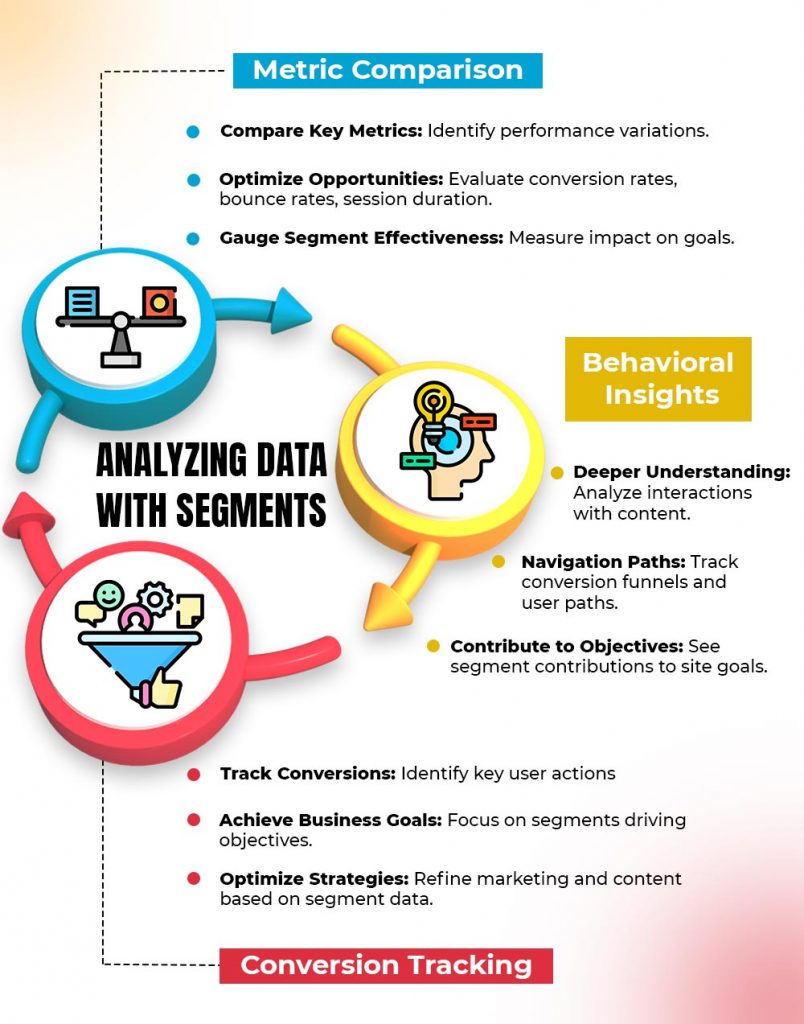Advanced segmentation techniques in Google Analytics
Introduction
Google Analytics offers a wealth of data through basic reports, but it’s true power is unlocked through advanced segmentation techniques. Segmentation allows you to create highly focused user groups based on various criteria, revealing hidden patterns and optimizing your website for specific audiences.
Benefits of Advanced Segmentation


Granular Audience Insights
Deep Understanding of User Behavior: By segmenting your audience, you can observe how different user groups interact with your site. This includes understanding which pages they visit, how long they stay, and what actions they take.
Preference Identification: Segments help you identify what content or products resonate most with specific groups, allowing you to tailor your offerings accordingly.
Value Assessment: By evaluating the behavior of different segments, you can determine which user groups are most valuable to your business in terms of engagement and conversion.
Improved Targeting
Tailored Marketing Campaigns: With detailed segment insights, you can create highly targeted marketing campaigns that address the specific needs and preferences of each group.
Enhanced Personalization: Use segmentation to personalize content, offers, and recommendations, increasing relevance and engagement.
Optimized Ad Spend: Focus your advertising budget on high-value segments, ensuring that your marketing dollars are spent more effectively.
Enhanced Performance Tracking
Identify High-Performing Segments: Discover which user groups are contributing the most to your key performance indicators (KPIs), such as sales, conversions, or engagement.
Spot Underperforming Segments: Recognize which segments are not meeting expectations, allowing you to investigate potential issues and make necessary adjustments.
Informed Decision-Making: Use segment performance data to guide strategic decisions and allocate resources to the most promising opportunities.
Optimized User Experience
Personalized User Journeys: By understanding how different segments navigate your site, you can create personalized experiences that cater to their specific needs and preferences.
Enhanced Site Navigation: Optimize the layout and structure of your website based on segment behavior to improve usability and satisfaction.
Targeted Content Delivery: Deliver content that is relevant and engaging to each segment, increasing the likelihood of user retention and conversion.
Improved Conversion Rates
Customized Conversion Paths: Design conversion paths that are tailored to the behaviors and preferences of different segments, making it easier for users to complete desired actions.
A/B Testing for Segments: Conduct A/B tests on specific segments to determine what changes or improvements drive better results, leading to more effective optimization efforts.
Focus on High-Value Segments: Prioritize segments that are more likely to convert, ensuring that your efforts are directed towards the most profitable opportunities.
Increased Customer Retention
Segment-Specific Retention Strategies: Develop retention strategies that address the unique needs and behaviors of different segments, improving overall customer loyalty.
Personalized Engagement: Use insights from segmentation to engage with customers in a more personalized manner, making them feel valued and understood.
Proactive Issue Resolution: Identify segments that are at risk of churning and take proactive steps to address their concerns and improve their experience.
Enhanced Reporting and Analysis
Detailed Insights: Segmentation provides a more detailed view of your data, allowing for more precise analysis and reporting.
Custom Reports: Create custom reports that focus on the metrics and dimensions that matter most to each segment, providing deeper insights.
Actionable Data: By breaking down data into meaningful segments, you can turn insights into actionable strategies that drive results.
Better Resource Allocation
Prioritized Initiatives: Use segment data to prioritize marketing and development initiatives, ensuring that resources are allocated to the most impactful areas.
Efficient Budget Use: Focus your budget on segments that provide the highest return on investment, maximizing the effectiveness of your spending.
Strategic Growth: Identify growth opportunities within specific segments and tailor your strategies to capitalize on these areas.
Types of Segments
Predefined Segments (System Segments)
Traffic Source Segments: Automatically categorize users based on how they arrived at your site, such as through organic search, paid search, social media, or direct visits.
Device Category Segments: Group users by the device they used to access your site, such as desktop, mobile, or tablet, helping you understand device-specific behavior and optimize accordingly.
Engagement Metrics Segments: Segments based on basic engagement metrics like bounce rate, session duration, and pages per session, allowing quick insights into user engagement levels.
Custom Segments
Custom Filters: Create segments using the segment builder by applying various filters like demographics, technology, behavior, and traffic sources, tailored to your specific analysis needs.
Advanced Logic Operators: Use AND/OR logic to combine multiple conditions and create highly specific user groups. For example, segment users who visited a particular page AND completed a specific goal.
Flexible Criteria: Define segments based on a combination of user actions, attributes, and conditions to target niche user groups and gain deeper insights.
Also Read: Use Analytics to Identify and Reduce Customer Churn
Common Segmentation Techniques


By User Behavior
Session Duration: Group users based on how long they stay on your site. Identify segments of highly engaged users versus those who leave quickly.
Page Views: Analyze segments based on the number of pages viewed per session to understand browsing patterns and engagement depth.
Event Completions: Track specific actions like form submissions, video plays, or social shares to understand user interactions and engagement.
By Content Viewed
Top Pages: Identify which pages are most frequently visited by different segments to understand their content preferences.
Content Grouping: Group related content together to see how specific segments interact with various content themes or categories.
Landing Pages: Segment users by the pages they land on to analyze entry points and the effectiveness of your landing pages.
By Traffic Source
Organic Search: Segment users who arrive via search engines to understand the effectiveness of your SEO efforts and keywords.
Paid Search: Analyze behavior of users coming from paid search campaigns to optimize your ad spend and targeting.
Social Media Referrals: Track users from different social media platforms to evaluate the performance of your social media marketing strategies.
By Technology
Device Type: Understand how users interact with your site on different devices (desktop, mobile, tablet) to ensure a responsive and optimized user experience.
Operating System: Segment users by their operating systems (Windows, iOS, Android) to identify platform-specific issues and opportunities.
Browser: Analyze user behavior based on the browser they use (Chrome, Firefox, Safari) to ensure compatibility and performance.
By Demographics (if enabled)
Location: Segment users by geographic regions to tailor content and marketing strategies to different locations.
Age & Gender: Analyze segments by age and gender (when compliant with privacy regulations) to understand demographic-specific behaviors and preferences.
Interests: Use affinity categories and in-market segments to identify user interests and tailor your marketing strategies accordingly.
Advanced Segmentation Techniques
Behavior Sequences
Page Sequence Analysis: Track the order in which users visit pages to understand common navigation paths and identify optimal conversion funnels.
Conversion Paths: Identify sequences leading to conversions to optimize and replicate successful user journeys.
Drop-off Points: Detect where users tend to drop off in their journey to improve navigation and reduce friction.
Event Segments
Specific Event Completions: Focus on users who complete key events (e.g., adding items to cart, playing a video) to analyze their journey and enhance event-triggered interactions.
Event Combinations: Segment users based on multiple event completions (e.g., adding to cart AND initiating checkout) to understand valuable multi-step behaviors.
Engagement Intensity: Identify segments based on the frequency or combination of events to recognize highly engaged users.
Custom Dimensions & Metrics To Check in Google Analytics
User Types: Create segments based on custom dimensions like user roles (e.g., logged-in users vs. guest users) to analyze specific user groups.
Product Categories: Use custom dimensions to segment users by the product categories they interact with, gaining insights into category-specific behavior.
Custom Metrics: Leverage custom metrics like time spent on specific sections or engagement with unique features to create detailed segments.
RFM Analysis (Recency, Frequency, Monetary Value)
Recency Segments: Group users by the time since their last visit or purchase to target recent, frequent, or dormant users.
Frequency Segments: Segment users based on how often they visit or purchase to identify loyal customers and target them with retention strategies.
Monetary Value Segments: Analyze users by their total spend to focus on high-value customers and personalize marketing efforts for maximum ROI.
Engagement Segments for Google Analytics
Time on Site: Segment users by the amount of time they spend on your site to identify highly engaged visitors.
Pages Viewed: Group users by the number of pages they view per session to understand browsing depth and engagement.
Repeat Visits: Identify segments based on the number of return visits to gauge user loyalty and satisfaction.
Google Analytics Relates Stats
Using Segments in Reports
Accessing Segments
Segments Section: Navigate to the “Segments” section within Google Analytics reports to manage and apply segments.
Selecting Segments: Choose from predefined segments or create custom segments using the segment builder to apply to your reports.
Applying Segments in Google Analytics
Predefined Segments: Apply system segments to quickly analyze common user groups based on default criteria such as traffic source, device category, or engagement metrics.
Custom Segments: Utilize the segment builder to create custom segments tailored to specific business goals and analysis requirements. Apply multiple segments simultaneously to compare and contrast different user behaviors and performance metrics.
Comparison Analysis: Conduct comparative analysis by applying different segments to uncover insights into how various user groups interact with your website and respond to marketing initiatives.
Analyzing Data with Segments


Metric Comparison: Compare key metrics across different segments to identify performance variations and opportunities for optimization. Evaluate metrics like conversion rates, bounce rates, and average session duration to gauge segment effectiveness.
Behavioral Insights: Gain deeper insights into user behavior by analyzing segment-specific interactions with content, navigation paths, and conversion funnels. Understand how different segments contribute to overall site goals and objectives.
Conversion Tracking: Track conversions within segments to pinpoint which user groups are driving desired actions and achieving business objectives. Optimize marketing strategies and website content based on segment-specific conversion data.
Additional Tips for Google Analytics
Start with Clear Goals: Define clear objectives for segmentation efforts, aligning them with overarching business goals such as improving user engagement, increasing conversions, or enhancing marketing ROI.
Combine Techniques: Use a blend of segmentation methods (e.g., behavior, demographics, and technology) to create comprehensive user profiles and tailor strategies for maximum impact.
Continuous Testing and Refinement: Regularly test and refine segments to ensure they remain relevant and effective as user behavior and market conditions evolve. Adapt segmentation strategies based on emerging trends and performance insights.
Data Privacy Compliance: Adhere to data privacy regulations (e.g., GDPR) when collecting and utilizing user data for segmentation purposes. Implement anonymization techniques and obtain user consent where necessary to maintain trust and compliance.
Visual Data Representation: Utilize data visualization tools such as charts, graphs, and dashboards to present segmentation insights in a clear and compelling manner. Facilitate informed decision-making and stakeholder communication through visual data representation.
Conclusion
By mastering advanced segmentation techniques in Google Analytics, businesses can unlock profound insights into their audience, optimize user experiences, and drive significant improvements in performance metrics. Whether analyzing user behavior, targeting specific demographics, or tracking campaign effectiveness, segmentation empowers businesses to make data-driven decisions that lead to sustained growth and competitive advantage in the digital landscape. Embrace the power of segmentation to transform raw data into actionable intelligence and propel your business towards greater success.







